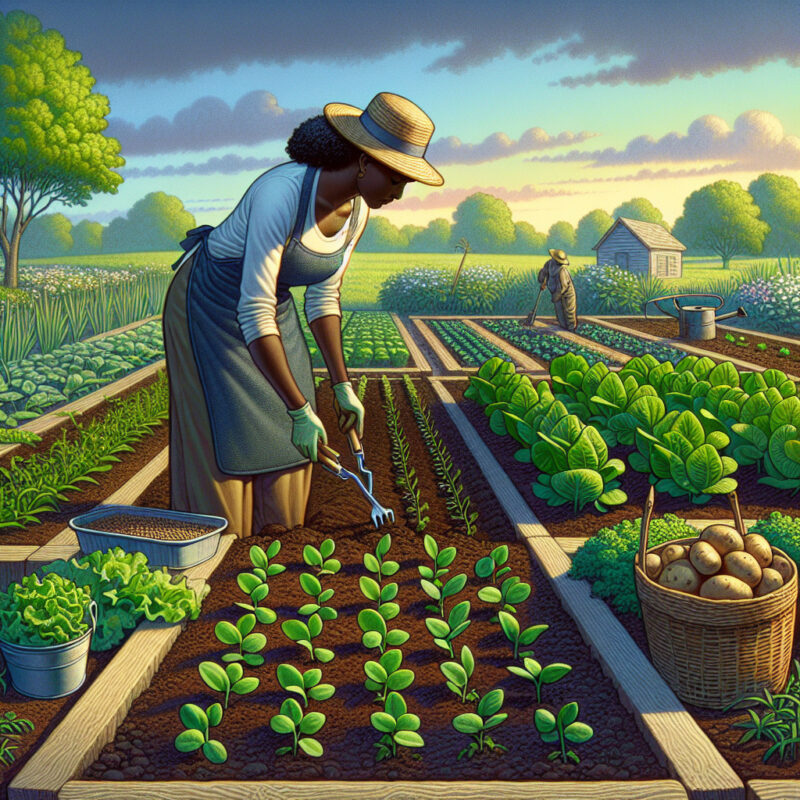March is a crucial month for garden enthusiasts in North Carolina as it marks the beginning of the spring season. With the transition from the cold winter months, March provides an opportune time for planting a variety of flowers, vegetables, and herbs. Whether you are a seasoned gardener or just starting out, understanding what to plant in March in NC will ensure a successful and fruitful growing season. By taking advantage of the favorable climate and following expert advice, you can create a vibrant and thriving garden that will bring joy and beauty to your outdoor space.
key Takeaways
- March is an ideal time to start planting vegetables and fruits in North Carolina.
- Sow cool-season vegetables like broccoli, cabbage, and carrots.
- Transplant onion sets, lettuce, and radish seedlings into the ground.
- Start planting warm-season vegetables such as tomatoes and peppers indoors, to be transplanted later.
- Begin sowing seeds for herbs like basil, cilantro, and dill.
- This is the perfect time to plant berries like strawberries and blackberries.
- Consider planting ornamental trees and shrubs in March.
- Ensure adequate watering and proper soil preparation for successful growth.
- Protect plants from unexpected late frosts or freezes by covering them at night.
- Plan and prepare your garden layout for the upcoming growing season.
What are the best plants to grow in North Carolina in March?
Rainfall
In North Carolina, March is usually characterized by increasing rainfall. This provides an ideal environment for certain plants that thrive in moist conditions. Taking advantage of the precipitation can greatly benefit your garden.
Temperature
March marks the transition from winter to spring in North Carolina. While temperatures can still be cool, certain plants can withstand colder weather and are ideal for planting during this time.
Hardy Vegetables
March presents a great opportunity to plant various hardy vegetables in North Carolina. These include lettuce, spinach, kale, and collard greens. These cold-tolerant vegetables benefit from the cooler temperatures, allowing them to establish strong roots before the heat of summer arrives.
Root Crops
Root crops are another excellent choice for March planting in North Carolina. Beets, carrots, radishes, and turnips can be sown during this time. The cool soil temperature promotes root growth and enhances the overall quality of these crops.
Herbs
March is an ideal month to start planting herbs in North Carolina. Popular options include cilantro, dill, parsley, and chives. These herbs will thrive in the cooler temperatures of early spring and provide aromatic additions to your culinary endeavors.
Strawberries
March is an exciting time for strawberry lovers in North Carolina. This is the perfect month to plant strawberries, whether you choose to grow them in your garden or in containers. Strawberries require a well-draining soil and full sun exposure to yield a bountiful harvest.
Flowers
To add vibrant colors and beauty to your garden, consider planting flowers in March. Varieties such as pansies, violas, and snapdragons thrive well in the cooler temperatures of early spring. These cheerful blooms will provide a stunning display in your garden or flower pots.
Perennials
March is a great time to plant perennial flowers in North Carolina. Perennials such as daylilies, hostas, and coneflowers can be planted during this month to establish strong root systems. These plants will reward you with beautiful blooms year after year.
Fruit Trees
If you have space in your garden, consider planting fruit trees in March. Apples, peaches, and cherries can be grown successfully in North Carolina. Ensure proper spacing and follow recommended pruning and care techniques to maximize fruit production.
Soil Preparation
Before planting any crops or flowers, it is essential to prepare the soil properly. Clear the area of any weeds or debris, then amend the soil with organic matter such as compost. This will enhance soil fertility, drainage, and overall plant health.
Remember, March in North Carolina offers excellent conditions for planting a variety of crops and flowers. Take advantage of this time to establish a thriving garden that will bring joy and abundance throughout the year.
Frequently Asked Questions
1. What are the best vegetables to plant in March in NC?
In March, the best vegetables to plant in North Carolina include lettuce, radishes, peas, kale, and broccoli. These cool-season crops thrive in the cooler temperatures of early spring and can tolerate occasional frosts. By planting them in March, you can enjoy a bountiful harvest in the coming months.
2. Should I start planting warm-season crops in March?
While some warm-season crops like tomatoes and peppers can be started indoors in March, it’s generally recommended to wait until April to plant them outdoors in North Carolina. This is because the nights can still be chilly, and frost can damage or kill young seedlings. It’s best to focus on cool-season crops in March and wait a few more weeks to start your warm-season plants.
3. Can I plant herbs in March?
Absolutely! March is an ideal time to start planting herbs in North Carolina. Popular herbs to plant in March include basil, parsley, cilantro, and chives. These herbs can be grown from seeds or transplants, depending on your preference. Just make sure to provide them with well-drained soil, plenty of sunlight, and regular watering to ensure healthy growth.
4. How often should I water the newly planted seeds in March?
Newly planted seeds in March should be watered regularly but not excessively. It’s important to keep the soil moist, but not waterlogged. Depending on the weather conditions, you may need to water them every 1-2 days. Keep an eye on the moisture level of the soil and adjust your watering schedule accordingly.
5. Can I plant fruit trees in March?
March is a great time to plant fruit trees in North Carolina. However, it’s important to select varieties that are suitable for the North Carolina climate. Some popular fruit trees that can be planted in March include apple trees, peach trees, and cherry trees. Make sure to choose a sunny location with well-drained soil and follow the planting instructions provided with the tree to ensure successful establishment.
Gardening Accessories: Essential Tools for a Successful Garden
1. Quality Gardening Gloves
Protect your hands while gardening with high-quality gardening gloves. They provide a barrier between your skin and any potential irritants, as well as protect against cuts and scratches. Look for gloves that are durable, comfortable, and offer a good grip.
2. Sturdy Garden Trowel
A garden trowel is a must-have tool for any gardener. It helps with digging, planting, and transplanting tasks. Look for a trowel with a sturdy blade and a comfortable handle that fits your hand well. This tool will become your go-to for many gardening tasks.
3. Hand Pruners
Hand pruners are essential for trimming and shaping plants in your garden. They are perfect for deadheading flowers, removing small branches, and pruning back unruly growth. Look for pruners that have sharp blades, a comfortable grip, and are easy to clean and maintain.
4. Garden Hoe
A garden hoe is a versatile tool that helps with weeding, cultivating the soil, and breaking up compacted dirt. Look for a hoe with a sharp, angled blade and a long handle for maximum efficiency and comfort while working in your garden.
5. Watering Can or Hose
To keep your plants healthy and hydrated, you’ll need a watering can or hose. Choose a watering can with a removable sprinkler head or a hose with a spray nozzle attachment to ensure even water distribution. Watering cans are great for small gardens or container plants, while hoses are more practical for larger areas.
Final Thoughts
In conclusion, March is an exciting time for gardeners in North Carolina as the weather begins to warm up, and the growing season kicks into gear. It is the perfect time to plant a variety of cool-season crops and herbs, ensuring a bountiful harvest in the coming months. While it’s best to wait until April for warm-season crops and fruitful trees, there are still plenty of options to fill your garden with greenery and freshness. By following the recommended planting tips, providing adequate water and care, utilizing essential gardening tools, and staying informed about the specific varieties suitable for your region, you can create a thriving and beautiful garden in North Carolina.
So, roll up your sleeves, gather your gardening tools, and get ready to enjoy the delight of growing your own plants and vegetables in March in North Carolina!

